PRINCETON, NJ -- Weekly averages of ������ Poll Daily consumer ratings show that, after being essentially flat for most of June and July, Americans' outlook for the economy improved slightly in the past week. This is seen in positive ratings of current economic conditions (16% now call them excellent or good) as well as in perceptions of the economy's direction (12% say it is getting better).
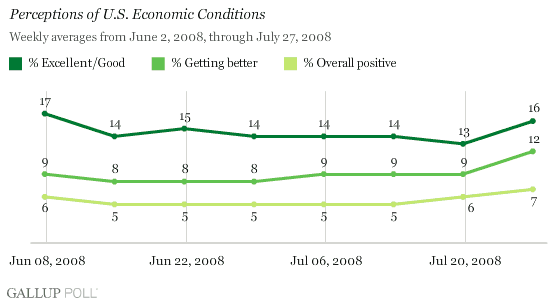
The net result is that the overall percentage of Americans holding "positive" views about the economy (based on a combination of their answers to the two questions) has inched up to 7%, from 5% at the start of the month. Another 14% have mixed views about current and future economic conditions, while 77% have solidly negative views.
The weekly aggregates are based on nationally representative samples of approximately 3,500 adults, and thus have a high degree of statistical reliability.
Long-Term, Confidence Still Down
The 12% now saying that economic conditions in the country are getting better is the highest this indication of positive consumer sentiment has reached since late February/early March. Still, it is only about half of its January level (which, relative to long-term trends, was already a depressed period for consumers). Similarly, the 16% calling current conditions excellent or good and the 7% net "positive" today are about 50% lower than early January readings.
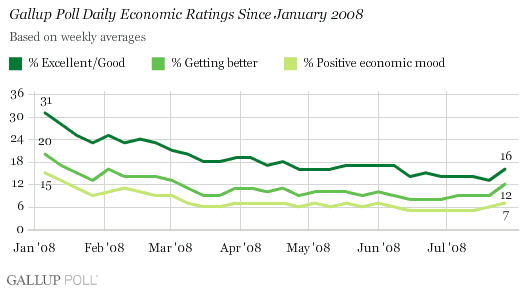
Gas Prices a Driving Force
The U.S. stock market and fuel prices at the pump have to some degree played tag team against consumer confidence this year. The stock market dropped sharply in early to mid-January, leveling off during much of February before continuing to trend downward through mid-March. It recovered somewhat in April and May, only to fall into a deep descent in June. It has thus far been quite volatile in July.
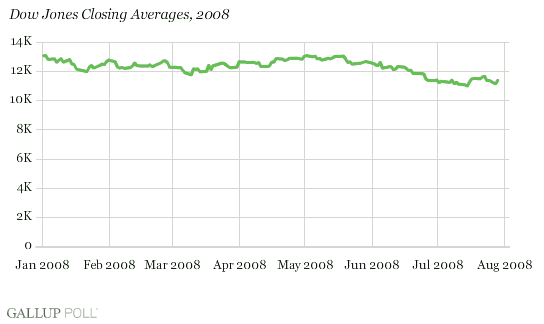
Gas prices began to take off in mid-February, reaching the $4-per-gallon mark in early June. The average price then leveled off at just over $4 for several weeks, but it has receded slightly in the past two weeks.
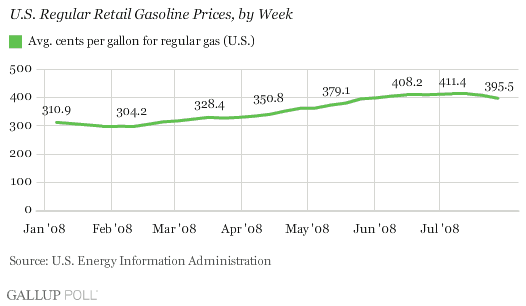
A special ������ analysis shows that the decline in public perceptions of the U.S. economy in the first quarter of 2008 (through mid-March) closely paralleled both the increase in gas prices and the decline in the U.S. stock market. Since then, consumer attitudes have been less closely related to shifts in the stock market, but remain highly correlated with changes in gas prices. In just the past two weeks (from July 14 through July 27), gas prices and consumer attitudes both improved slightly, while the stock market fluctuated.
Bottom Line
Multiple aspects of the U.S. economy are problematic right now, including the housing market, the mortgage industry, various retail sectors, and the labor market, in addition to energy costs and a tumultuous stock market. Americans could be relying on the news about any or all of these factors when forming their overall economic views. However, gas prices may currently be having the most influence.
While a majority of Americans have money invested in the stock market, only 24% in January told ������ that the sharp decline in the market at that time was having a "very negative" impact on their family's financial situation. This contrasted with the 57% -- even then -- saying that the rise in gasoline and home heating prices was having a very negative impact on them.
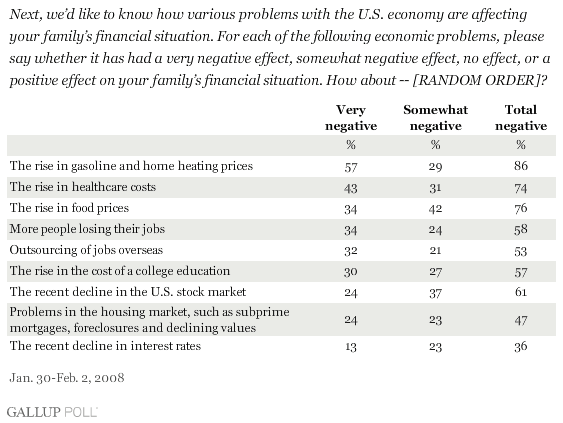
More recently, as Americans' most important financial problem, and large majorities say they are cutting back on their spending as a result.
The uptick in consumer confidence this month is only a marginal improvement of an otherwise grim picture. However, it is a positive change, and one that appears to reflect a slight sigh of relief on the part of Americans at the pump. Given the 2008 trends, further declines in gas prices this year could be just what it takes to keep consumer confidence moving in a positive direction, which could in turn have a positive ripple effect on retail spending, the housing market, employment, and ultimately, gross domestic product.
Survey Methods
For the ������ Poll Daily tracking survey, ������ interviews no fewer than 1,000 U.S. adults nationwide each day. The economic questions analyzed in this report are asked of a random half-sample of respondents, or about 500 U.S. adults nationwide each day. The average weekly results reported here are based on combined data from approximately 3,500 interviews conducted each week from Monday through Sunday.
For results based on samples of this size, the maximum margin of sampling error is ±2 percentage points. Percentages closer to 10% and 90% in each weekly sample are associated with a margin of sampling error of ±1 percentage points.
Interviews are conducted with respondents on land-line telephones (for respondents with a land-line telephone) and cellular phones (for respondents who are cell-phone only).
In addition to sampling error, question wording and practical difficulties in conducting surveys can introduce error or bias into the findings of public opinion polls.
To provide feedback or suggestions about how to improve ������.com, please e-mail feedback@gallup.com.
